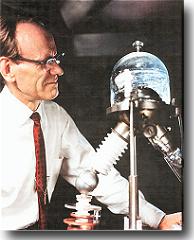|
Fusion. It's the Holy Grail of modern science: Clean, cheap, abundant engergy. And it's easy: Just take two hydrogen atoms, and heave 'em together, until they become a helium atom. What makes it interesting is, that helium atom has less mass than those two hydrogen atoms, and the difference is given off as energy according to a little formula that Einstein whipped up: E=MC2. The appeal of fusion is undeniable: the fuel that makes it possible exists in sea water, in such quantities that the planet's current energy needs could easily be met until long after the sun itself has burned into cosmic meatball. And (theoretically, at least), in its most refined form, the reaction produces no radioactive by-products, and no toxic waste at all. Unlike its wicked stepsister, fission (which exists only in nuclear reactors here on earth), fusion exists in great abundance in nature. Every star in the heavens is a fusion reactor. Our own sun is a fusion reactor. The process is so efficient that when God Himself was looking for away to power and light His Universe, he settled on fusion. Recreating that process here on Earth, though is an entirely different story. You see, those hydrogren atoms are both positively charged. Like the poles of a magnet, those similarly-charged particles have a tendency to repel each other, unless they can be heated to extremely high temperatures, i.e. millions of degrees Centigrade, like the conditions found at the center of your average star. This is the conundrum facing scientists trying to develop fusion as a practical source of power: if you can heat the particles to the extreme temperatures necessary to begin the reaction, one of two things will happen: either the hot reactive mass will destroy its container, or the container will cool and shut down the reaction. Either way, you can see, fusion is not going to be easy to achieve. Of course, that hasn't stopped the scientific establishment - the laboratories and physicist withs the big government-funded budgets - from spending, literally, billions and billions of dollars over the past 50 years trying to get the genie in the bottle. They have tried to contain fusion with giant whirling magnets (magnetic confinement) and high-powered lasers (inertial confinement). But all they have to show for their efforts are giant machines that consume large quantities of money while producing infinitesimally small amounts of energy. Or, even worse, we get drawn into a web of intritgue over the notion of "Cold Fusion," which only serves to stimulate our interest in the subject and demonstrate just how far the scientific establishment is from finding any sort of truly useful approach to the quandary. Well, if this was the case, then why don't we have fusion today? Why are we still choking on fossil fuel emissions, greenhouse gasses, and noxious fumes if Philo T. Farnsworth figured out 30 years ago how to derive electricity from the same process that powers the stars? Why do we still worry about importing foreign oil when all the fuel we need sits right on our shores? And why do we blast vehicles into outer space with explosive rockets when they could just as well be lifted with a gentle fusion propulsion system? Why indeed. The purpose of this webspace will be to explore those questions. The author makes no promises of finding answers. It is hoped that this website will become forum where interested parties can learn about, and perhaps discuss, what happened in Farnsworth's laboratories in the 1960's, and whether there might be any merit to recreating that work today. To facilitate this discussion, I will be providing links, articles, and excerpts from "Distant Vision, Romance and Discovery on the Invisible Frontier, Elma G. (Pem) Farnsworth's memoir of her life as the wife of the man who gave us television and then spent the second half of his life devoted to the most challenging and exciting scientific pursuit of our time. Among the materials you can expect to find here:
|
| A more detailed account of Farnsworth's life, the origins of his fusion work and the mysteries surrounding its conclusion is now part of a new book, The Boy Who Invented Television: A Story of Inspiration, Persistence, and Quiet Passion. Learn more about the book here or click the book store of your choice to order a copy online. |
Return to: || The Farnovision || Comments? || Discussion?
� 1977, 2001Paul Schatzkin; All Rights Reserved For more information contact: The Perfesser |


